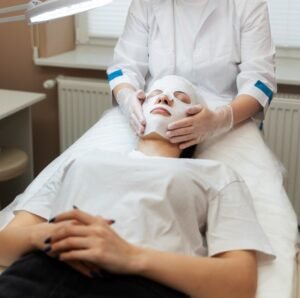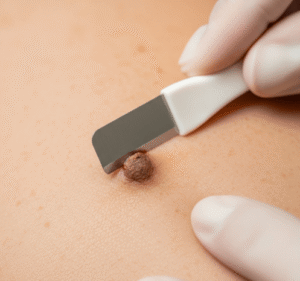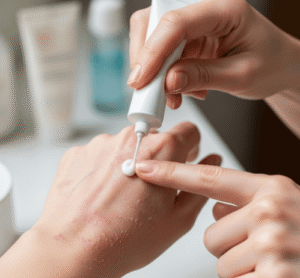Overview
Ulnar wrist pain is a condition that refers to discomfort, tenderness, or aching felt on the little-finger side of the wrist, where the ulnar bone is located. This part of the wrist is particularly complex, made up of multiple bones, cartilage structures, tendons, and ligaments, making it vulnerable to injuries and degenerative conditions.
Many individuals experience ulnar wrist pain due to repetitive strain, trauma, or underlying joint diseases. It is especially common among people who play racket sports, gymnasts, golfers, or those whose jobs involve constant typing, lifting, or twisting motions.
➤ Pain on the ulnar side of the wrist may seem like a small issue, but it can interfere with gripping, twisting, writing, and carrying objects.
➤ Ignoring persistent pain can lead to chronic conditions or long-term disability.
➤ Early diagnosis and proper treatment are crucial for recovery and prevention of complications.
Key Facts
► Location of pain: Felt on the side of the wrist near the little finger.
► Common causes: Sports injuries, arthritis, TFCC (triangular fibrocartilage complex) tears, and fractures.
► Who is at risk: Athletes, office workers, musicians, and manual laborers.
► Warning signs: Pain with twisting motions, clicking sounds, swelling, or grip weakness.
► Treatment in Korea: Advanced imaging, minimally invasive surgeries, and modern rehabilitation programs.
What is Ulnar Wrist Pain?
Ulnar wrist pain is not a disease itself but a symptom of underlying musculoskeletal or neurological issues. The pain originates from the ulnar side of the wrist, where several important anatomical structures are located:
➔ The ulna bone, one of the two forearm bones.
➔ The TFCC (triangular fibrocartilage complex), which acts as a cushion and stabilizer.
➔ Carpal bones such as the pisiform and triquetrum.
➔ Ligaments and tendons that support wrist movement.
➔ The ulnar nerve, which controls sensation in part of the hand.
Because this region has so many interconnected structures, even a small injury can cause persistent pain, swelling, or clicking sounds when moving the wrist. Patients often report discomfort while performing activities such as typing, lifting, turning doorknobs, or playing sports.
What Symptoms Are Related to Ulnar Wrist Pain?
Ulnar wrist pain rarely occurs alone. It is often accompanied by other symptoms depending on the cause. Some common associated signs include:
→ Swelling, redness, or localized tenderness.
→ A clicking, popping, or grinding sound when moving the wrist.
→ Pain that worsens with rotation or heavy lifting.
→ Weakness in grip strength or difficulty holding objects.
→ Tingling or numbness, which may indicate ulnar nerve compression.
→ Stiffness and reduced range of motion.
When these symptoms persist or worsen, it usually signals an underlying injury, degeneration, or compression issue that requires medical attention.
What Causes / Possible Causes of Ulnar Wrist Pain?
● Injuries and Trauma
➤ TFCC tear: One of the most common causes, often due to falls, sports injuries, or repetitive twisting.
➤ Fractures: A break in the ulna or surrounding carpal bones can cause severe pain and long-term stiffness.
➤ Ligament sprains: Overstretching or tearing of supporting ligaments can destabilize the wrist.
● Degenerative Conditions
► Ulnar impaction syndrome: When the ulna is longer than the radius, it can put abnormal pressure on the cartilage.
► Osteoarthritis: Wear-and-tear of wrist joints over time.
► Rheumatoid arthritis: An autoimmune condition that inflames and damages joint tissues.
● Nerve-Related Problems
➔ Guyon’s canal syndrome: Compression of the ulnar nerve at the wrist, causing tingling, numbness, and weakness.
➔ Repetitive strain: Activities like constant typing or playing musical instruments can irritate nerves.
● Other Factors
→ Poor wrist ergonomics while working.
→ Overuse from sports, especially tennis, golf, and gymnastics.
→ Ganglion cysts pressing on wrist structures.
When Should I See My Doctor?
While mild ulnar wrist pain may improve with rest, there are certain warning signs that should not be ignored:
➤ Pain lasting longer than 1–2 weeks despite home care.
➤ Sudden swelling, deformity, or bruising after a fall.
➤ Tingling, numbness, or burning sensations in the hand or little finger.
➤ Difficulty gripping objects or frequent dropping of items.
➤ Severe stiffness or reduced wrist movement.
If any of these occur, it is important to see a doctor promptly. Ignoring these symptoms may lead to chronic pain, nerve damage, or permanent loss of wrist function.
Care and Treatment
Self-Care at Home
► Rest and avoid activities that worsen the pain.
► Apply ice packs to reduce inflammation.
► Wear a wrist brace to stabilize the joint.
► Take over-the-counter painkillers such as ibuprofen.
Medical Treatments
➔ Prescription anti-inflammatory medications.
➔ Corticosteroid injections for severe inflammation.
➔ Physical therapy to strengthen muscles and improve flexibility.
Advanced Treatments
→ Arthroscopic surgery for TFCC repair.
→ Ulnar shortening osteotomy (correcting bone length issues).
→ Nerve decompression surgeries for Guyon’s canal syndrome.
Recovery depends on the cause, but with proper treatment, most people regain pain-free wrist function.
Treatment Options in Korea
South Korea is known for its advanced orthopedic and sports medicine care, making it a popular destination for patients with wrist problems.
Diagnosis in Korea
➤ MRI and CT scans for detailed imaging.
➤ Ultrasound for tendon and ligament evaluation.
➤ Diagnostic arthroscopy for direct joint visualization.
Non-Surgical Care
► Personalized physiotherapy programs.
► PRP (Platelet-Rich Plasma) injections to speed healing.
► Pain management and ergonomic education.
Surgical Excellence
➔ Minimally invasive arthroscopic surgeries with faster recovery.
➔ Robotic-assisted precision in bone surgeries.
➔ World-class orthopedic surgeons with specialized wrist expertise.
Rehabilitation in Korea
→ Comprehensive rehab centers with sports-specific programs.
→ Occupational therapy for workers who need quick return to jobs.
→ Preventive guidance on ergonomics and lifestyle modifications.
South Korea combines cutting-edge technology with affordable healthcare costs, making it a top choice for patients worldwide seeking effective wrist pain treatment.













